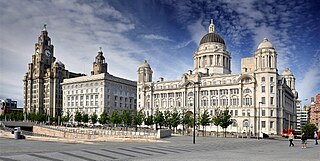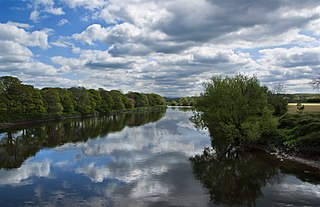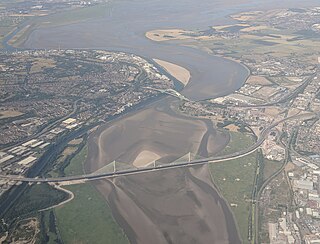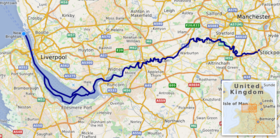
Merseyside is a ceremonial and metropolitan county in North West England. It borders Lancashire to the north, Greater Manchester to the east, Cheshire to the south, the Welsh county of Flintshire across the Dee Estuary to the southwest, and the Irish Sea to the west. The largest settlement is the city of Liverpool.

The River Mersey is a major river in North West England. Its name derives from Old English and means "boundary river", possibly referring to its having been a border between the ancient kingdoms of Mercia and Northumbria. For centuries it has formed part of the boundary between the historic counties of Lancashire and Cheshire.

The Bristol Channel is a major inlet in the island of Great Britain, separating South Wales and South West England. It extends from the smaller Severn Estuary of the River Severn to the North Atlantic Ocean. It takes its name from the English city and port of Bristol.

Tidal power or tidal energy is harnessed by converting energy from tides into useful forms of power, mainly electricity using various methods.

The River Ribble runs through North Yorkshire and Lancashire in Northern England. It starts close to the Ribblehead Viaduct in North Yorkshire, and is one of the few that start in the Yorkshire Dales and flow westwards towards the Irish Sea.

The River Alt is an urban river that flows across Merseyside in England. The river has suffered from heavy pollution from industry and sewage upstream and run-off from farmland in its lower reaches. It empties into the River Mersey, near to where the Mersey itself flows into the Irish Sea. The river has benefited from clean-up schemes and a de-culverting process to improve its water quality and provide a better environment for wildlife.

The Severn Estuary is the estuary of the River Severn, flowing into the Bristol Channel between South West England and South Wales. Its very high tidal range, approximately 50 feet (15 m), creates valuable intertidal habitats and has led to the area being at the centre of discussions in the UK regarding renewable tidal energy.

The Severn Barrage is any of a range of ideas for building a barrage from the English coast to the Welsh coast over the Severn tidal estuary. Ideas for damming or barraging the Severn estuary have existed since the 19th century. The building of such a barrage would constitute an engineering project comparable with some of the world's biggest. The purposes of such a project have typically been one or several of: transport links, flood protection, harbour creation, or tidal power generation. In recent decades it is the latter that has grown to be the primary focus for barrage ideas, and the others are now seen as useful side-effects. Following the Severn Tidal Power Feasibility Study (2008–10), the British government concluded that there was no strategic case for building a barrage but to continue to investigate emerging technologies. In June 2013 the Energy and Climate Change Select Committee published its findings after an eight-month study of the arguments for and against the Barrage. MPs said the case for the barrage was unproven. They were not convinced the economic case was strong enough and said the developer, Hafren Power, had failed to answer serious environmental and economic concerns.

The production of renewable energy in Scotland is a topic that came to the fore in technical, economic, and political terms during the opening years of the 21st century. The natural resource base for renewable energy is high by European, and even global standards, with the most important potential sources being wind, wave, and tide. Renewables generate almost all of Scotland's electricity, mostly from the country's wind power.

Liverpool Waters is a large scale £5.5bn development that has been proposed by the Peel Group in the Vauxhall area of Liverpool, Merseyside, England. The development will make use of a series of presently derelict dock spaces at Central Docks. From 2004 to 2021, much of the docks involved in the development were part of the Liverpool Maritime Mercantile City, a UNESCO World Heritage Site, but the development of these docks were cited as a reason for the revocation of Liverpool's World Heritage status. This is an area north of Liverpool's historic Pier Head. It is the sister programme of the Wirral Waters project. Since 2012 the two projects have held enterprise zone statuses, together forming the Mersey Waters Enterprise Zone.
Severn Tidal Power Feasibility Study is the name of a UK Government feasibility study into a tidal power project looking at the possibility of using the huge tidal range in the Severn Estuary and Bristol Channel to generate electricity.

The Mersey Gateway Bridge is a toll bridge between Runcorn and Widnes in Cheshire, England, which spans the River Mersey and the Manchester Ship Canal. The crossing, which opened in October 2017, has three traffic lanes in each direction and is approximately 1.5 km east (upstream) of the older Silver Jubilee Bridge. It formed part of a wider project to upgrade the infrastructure around the Mersey crossings that included major civil engineering work to realign the road network, refurbish and add tolling to the Silver Jubilee Bridge, and build new interchanges.

The Outer Trial Bank is a circular artificial island in the Wash, East Anglia, England. It is one of two artificial islands constructed during the 1970s for a proposed UK governmental water resources scheme.

Steven Philip Rotheram is a British Labour politician who has served as the Mayor of the Liverpool City Region since 2017.

A tidal barrage is a dam-like structure used to capture the energy from masses of water moving in and out of a bay or river due to tidal forces.
Atlantic Gateway, sometimes referred to as Ocean Gateway, is a proposed redevelopment strategy for North West England, centering on the corridor between Greater Manchester and Merseyside. The proposal is for development backed by £50 billion of investment over 50 years, making it one of the most expensive and expansive development projects in UK history.
Tidal Lagoon Swansea Bay was a proposed tidal lagoon power plant that was to be constructed in Swansea Bay off the south coast of Wales, United Kingdom. Development consent was granted by the UK government in June 2015, and in June 2018 the Welsh Government approved the plan and offered to invest £200 million; however, later that month the UK government withdrew its support on value-for-money grounds. Other options to enable the proposal to go ahead were reportedly still being explored.

SIMEC Atlantis Energy is a renewable energy company. It is incorporated in Singapore, but its operational headquarters are in Edinburgh, Scotland, United Kingdom. Initially, it was a developer of the tidal power turbines and projects, but after becoming a part of GFG Alliance it has expanded its business also to the waste-to-energy and hydropower.

Centre Port is a proposed development across The Wash in Eastern England, which would link Norfolk and Lincolnshire by road. The plan is to link Hunstanton in Norfolk, with Gibraltar Point in Lincolnshire, creating an 11-mile (18 km) road, with a port and a railway at the midway point. Additionally the development would be a tidal barrage to prevent sea flooding, and would use tidal power to create enough electricity to power 600,000 homes. Whilst no formal plans have yet been submitted, the scheme has come under widespread criticism from those living in the area and from wildlife groups.



















